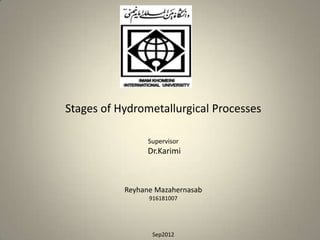
Stages of hydrometallurgical processes
- 1. Stages of Hydrometallurgical Processes Supervisor Dr.Karimi Reyhane Mazahernasab 916181007 1 Sep2012
- 2. Content • Introduction • Process Stages Leaching Solution concentration and purification Metal recovery • Hydrometallurgy Versus Pyrometallurgy Conclusion • References 2
- 3. Introduction • Hydrometallurgy is a metal processing technology that uses a chemical process combining water, oxygen or other substances in a pressurized or other vessel to dissolve a metal from its ore, concentrate or an intermediate product . Further processing is required to produce high purity metal.[1] 3
- 4. Process Stages • Hydrometallurgy is typically divided into three general areas: Leaching Solution concentration and purification Metal recovery 4
- 5. Process Stages Figure 1: Basic unit processes in hydrometallurgy. [4] 5
- 6. Process Stages • The most important operation in hydrometallurgy is leaching of properly prepared raw material.[2] • The most efficient leaching agents are acids, due to their ability to leach both base and precious metals. Generally, base metals are leached in nitric acid.[5] 6
- 7. Process Stages The three basic leaching techniques are: In-situ leaching Heap leaching Vat leaching Agitation leaching 7
- 8. Process Stages Insitu leaching: In-situ leaching is concerned with the dissolution of metal values from minerals present in the undisturbed ore body in place.[4] suitable for low-grade ores [4] cheaper than other techniques[4] Figure2: Insitu leaching 8
- 9. Process Stages Heap leaching: ore is crushed & piled onto an artificial pad and then solution is trickled on it.[9] • A major advantage of heap leaching is the elimination of expensive milling operations since the ore body need not be crushed to sizes much smaller than 20 to 25 mm.[4] Figure3: Heap Leaching 9
- 10. Process Stages Vat Leaching :The ore meant to be leached is loaded into vats that are typically made of concrete. When leaching has been completed, the residual solids are dugout of the vat and replaced by a fresh batch of ore.[4] Suitable for porous and sandy materials [4] commonly used to extract gold and silver from ore [11] 10
- 11. Process Stages • Agitation leaching :A process where the soil is slurried with the extraction fluid for a period of time. When equilibrium between the metal on the soils surface and the metal contained by the solution is approached, the solubilization of the metal in the soil is slowed, and the extraction is considered to be complete. [10] 11
- 12. Process Stages Solution purification and concentration : This step usually involves chemical separations. removing undesirable impurities to Purpose increase the metal concentration • the solution purification can be stated to be achieved by using any one or a combination of the following processes[4] : ion exchange carbon adsorption solvent extraction 12
- 13. Process Stages • Metal recovery: At this point, the metal needs to be recovered from solution in the solid form. This is either achieved chemically, or electrochemically.[9] Electrowinning: An electrochemical process for precipitating metals from solution.[9] The anode is made out of a material that will not easily oxidise or dissolve, such as lead or titanium.[9] Figure4:Electrowining process [4] 13
- 14. Hydrometallurgy Versus Pyrometallurgy • Pyrometallurgy: Pyrometallurgy, or the use of heat for the treatment, includes smelting and roasting. It involves heating in a blast furnace at temperatures above 1500°C to convert waste to a form that can be refined.[6] 14
- 15. Hydrometallurgy Versus Pyrometallurgy •A number of factors are causing a gradual but steady shift away from the traditional processing routes.[7] Figure5. Growing importance of Hydrometallurgy [7] 15
- 16. Hydrometallurgy Versus Pyrometallurgy • Compared with pyrometallurgy, hydrometallurgical extraction of metals from their ores is more attractive. This attractiveness is attributed to: economical environmental technical reasons.[8] 16
- 17. Hydrometallurgy Versus Pyrometallurgy • Factors such as low temperature processing; low handling cost of leaching products and possibility of treatment of low grade ores make leaching more preferable than high temperature smelting.[8] • In conventional pyrometallurgical smelting, sulphides are burnt off, creating SO2 gas, which is released as air emissions.With hydrometallurgy, there are no air emissions. [1] 17
- 18. Hydrometallurgy Versus Pyrometallurgy • However, some problems may arise during hydrometallurgical operations. These include: difficulties in solid–liquid separation effect of impurities on the ease of purification The principal disadvantage of hydrometallurgical operations is probably the process times required to achieve high metal recovery since these processes are often carried out at low temperatures compared to pyrometallurgical processes.[8] 18
- 19. Conclusion • Advantages of hydrometallurgy: Much more environmentally friendly than pyrometallurgy. Compared to pyrometallurgy, only a fraction of the gases liberated into the atmosphere. Low capital cost Ability of complex and low-grade ores extraction 19
- 20. conclusion • Disadvantages of hydrometallurgy: Large amount of water used, greater potential for contamination. Difficulties in solid–liquid separation Impurities problems in purification process Times needed for high metal recovery 20
- 21. References • [1] www.vale.com • [2] Katarzyna OCHROMOWICZ ,Tomasz CHMIELEWSKI-Physicochem. Probl. Miner. Process. 46(2011) 207-218 , July 2010 • [3] Chapter 82 - Metal Processing and Metal Working Industry • [4] Chemical Metallurgy: Principles and Practice. Chiranjib Kumar Gupta • [5] Željko Kamberović *, Marija Korać, Dragana Ivšić, Vesna Nikolić,Milisav Ranitović , HYDROMETALLURGICAL PROCESS FOR EXTRACTION OFMETALS FROM ELECTRONIC WASTE, Department of Metallurgical Engineering, Faculty of Technology and Metallurgy, Belgrade, Serbia • [6] F.C. Liew,Engineering Department,TES-AMM Singapore,April 2008 • [7] DREISINGER, D, Hydrometallurgical process development for complex ores and concentrates. Hydrometallurgy Conference 2009, The Southern African Institute of Mining and Metallurgy,2009. 21
- 22. References • [8] M. Al-Harahsheh , S.W.Kingman, Microwave-assisted leaching—a review, Hydrometallurgy Volume73,Issues 3-4,June 2004, Pages 189–203 • [9] Hydrometallurgy,Dr. yoozbashizade-Hossein, Industrial University Of Sharif • [10] http://www.hydrometallurgy.metal.ntua.gr/Heap%20Leaching.htm • [11] http://www.americhem.biz/_amprep/leaching.htm 22
